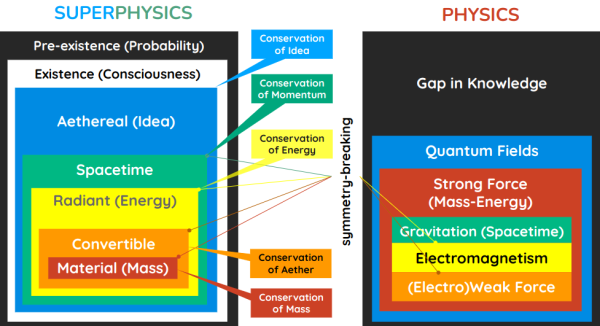The Conservation Laws
Table of Contents
Each of the 5 Layers (Elements in Cartesian Physics) implements a Conservation Law in order to maintain the balance in the universe because:
- our universe is really one Supreme Entity, as a single unit
- a change in one aspect or part affects the whole
[The 2nd Rule of movement] proves immutability of God’s operation, conserving the world now with the same action with which He once created it. God from the start moved its various particles in different ways and arranged them so that some particles would impel others and transfer their motions to them. He conserves motion by letting those motions pass from one to another as they encounter each other. Thus, this continuous alteration of creatures itself is an argument for the immutability of God.
Rene Descartes
Principia Philosophia, Article 42
This leads to 5 Conservation Laws, 1 for each Layer.
| Layer | Conservation Law |
|---|---|
| Aethereal | Idea or Identity |
| Spatial | Momentum |
| Radiant | Energy |
| Convertible | Aether |
| Material | Mass |

Each law has its implementing rules which will be discussed in each Part for each layer.
In summary:
- the singleness of the Supreme means that a change in one part affects all others.
- this affecting of parts is called relationality
- the job of relationality is to conserve the singleness of the unit
Modern Physics sees the Conservation Laws as effect of Symmetry which is confusing cause as effect.
In contrast, Material Superphysics sees the Conservation Laws as the fundamental forces (i.e. Standard Model) as the Effect of Conservation which in turn is the effect of the Supreme Entity being a single entity.

The Law of Conservation of Identity
This is the Material Superphysics version of the Law of Conservation of Idea of Superphysics.
This operates in the aethereal layer and is the foundation of the gravitational signature which this law says must be unique.
This then leads to movement as those signatures adhere to this law in the physical domain.
The Law of Conservation of Momentum
This operates in the spatial layer and is the foundation of the rules of motion which are the implementing rules for this law.
The Law of Conservation of Energy
This operates in the radiant layer and is already well known in Physics. Energy is the crudified version of momentum.
This actually changes the energy from electromagnetic to material motion. For example, a generator converts electromagnetic force into physical motions.
The Law of Conservation of Aether
This operates in the convertible layer which facilitates particle decay and in “flavor changing” which then creates the diversity of the material layer below it.
This is because the Conversion layer converts matter the energy and vice versa.
Flavor changing is a good and natural word for this layer because traditionally this was called the Water Element.
It is the wetness of water and liquids that allows both:
- the perception of tastes by our tongue
- the detection of neutrinos by large liquid detectors.
The Law of Conservation of Mass
This operates in the material layer and is already well known in Physics. Matter is facilitated by the static aetherspace and is the most crudified version of the aether.